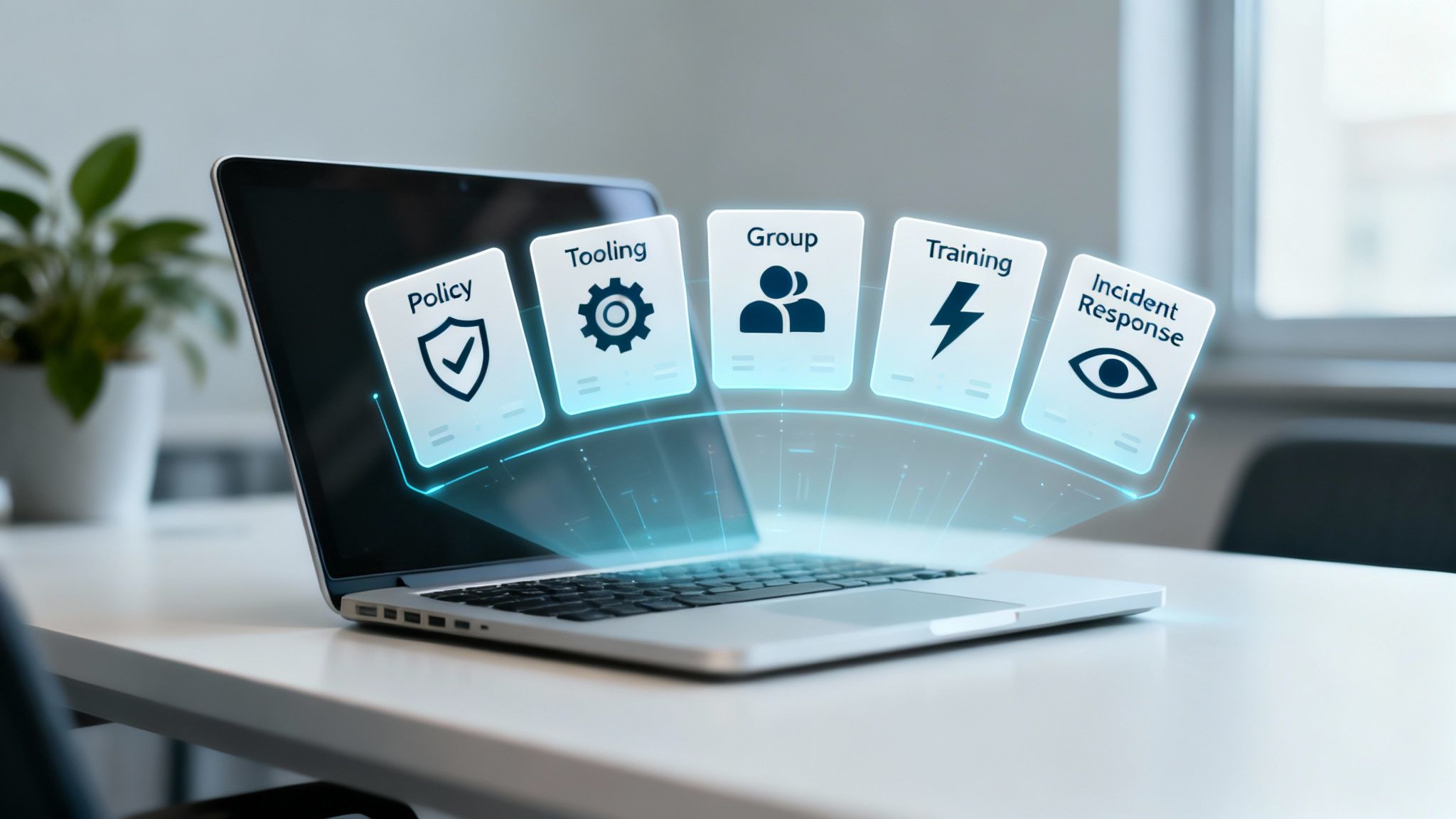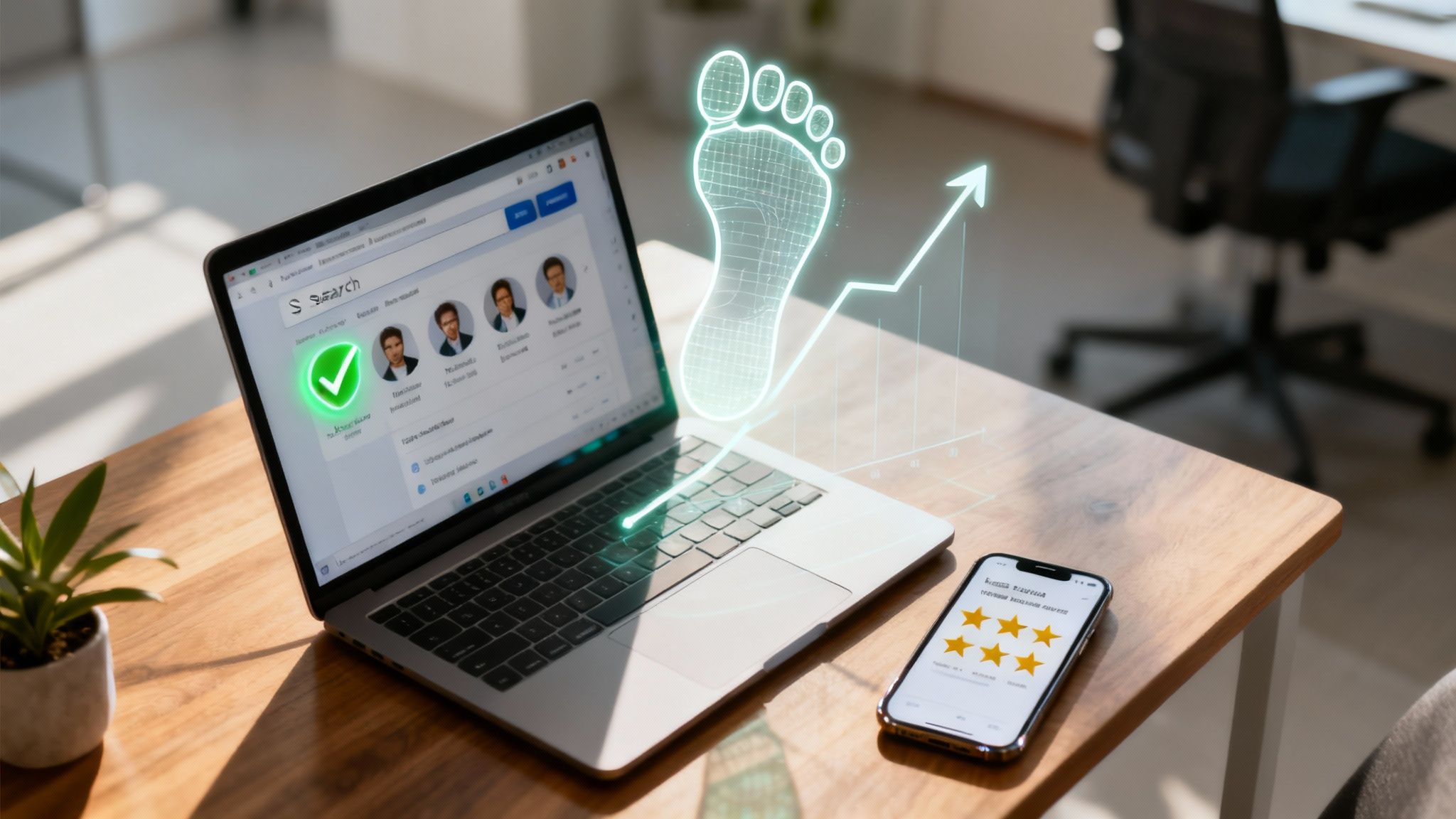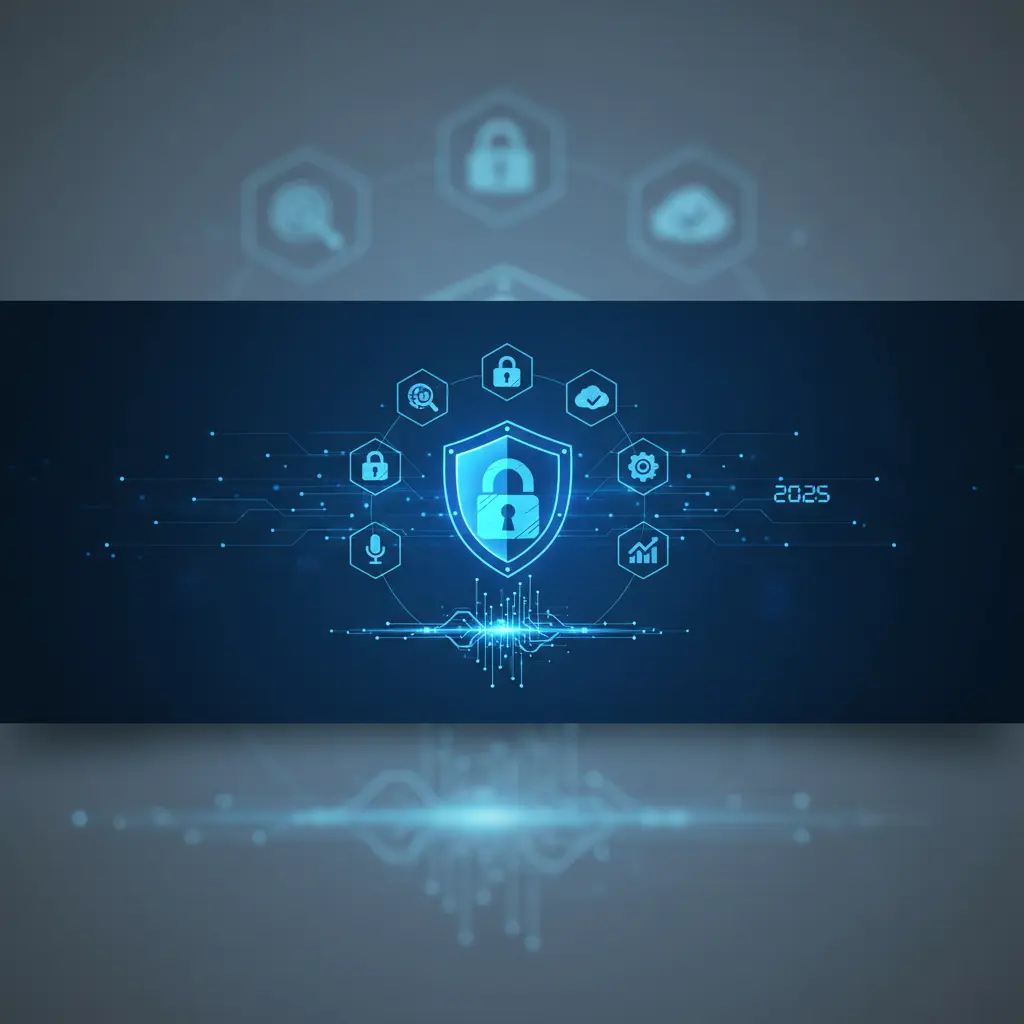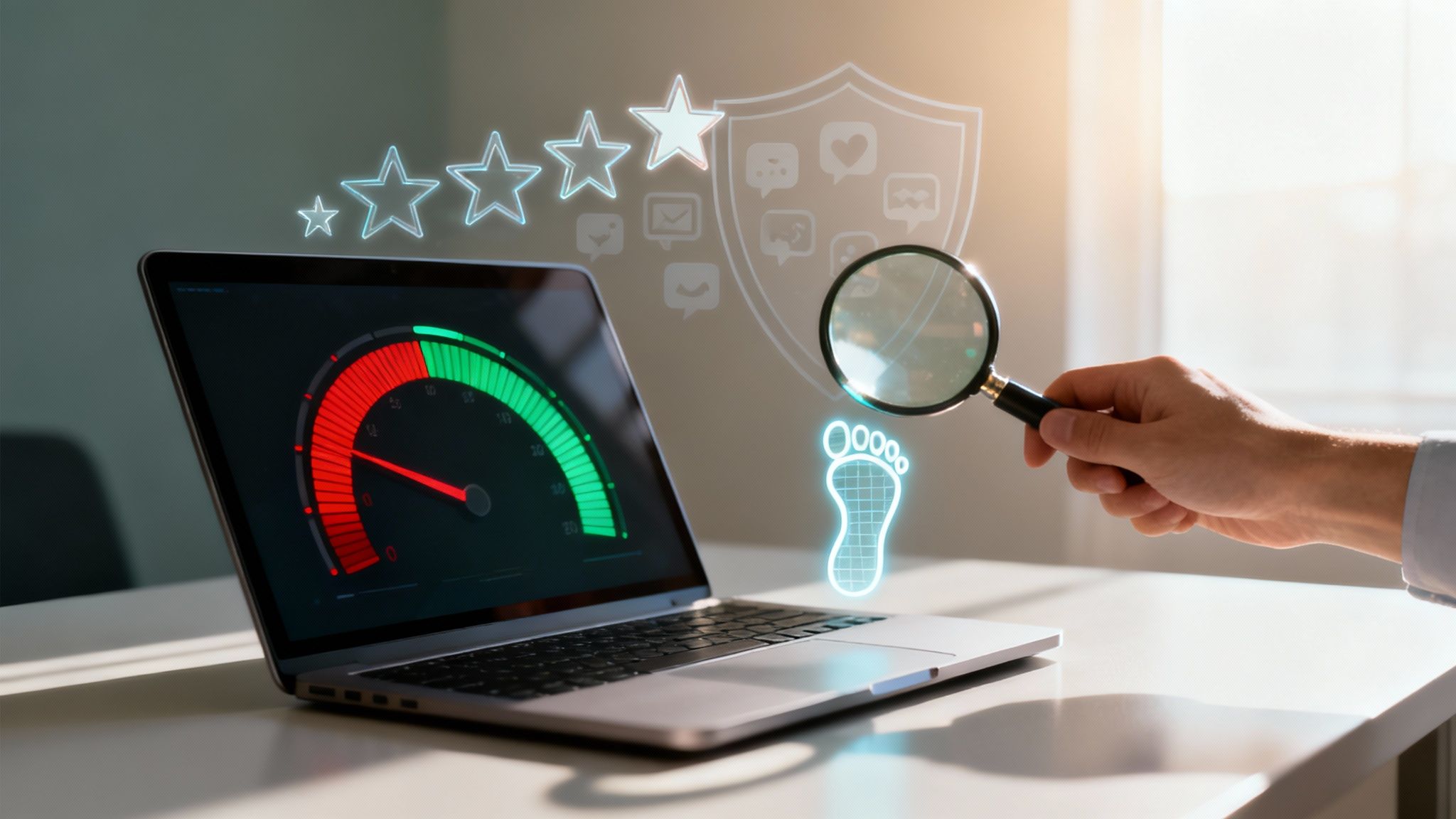· Digital Footprint Check · Content Marketing · 23 min read
8 Personal Cybersecurity Best Practices for 2025
Discover 8 essential personal cybersecurity best practices to protect your digital life. Learn about passwords, MFA, phishing, and more in our detailed guide.
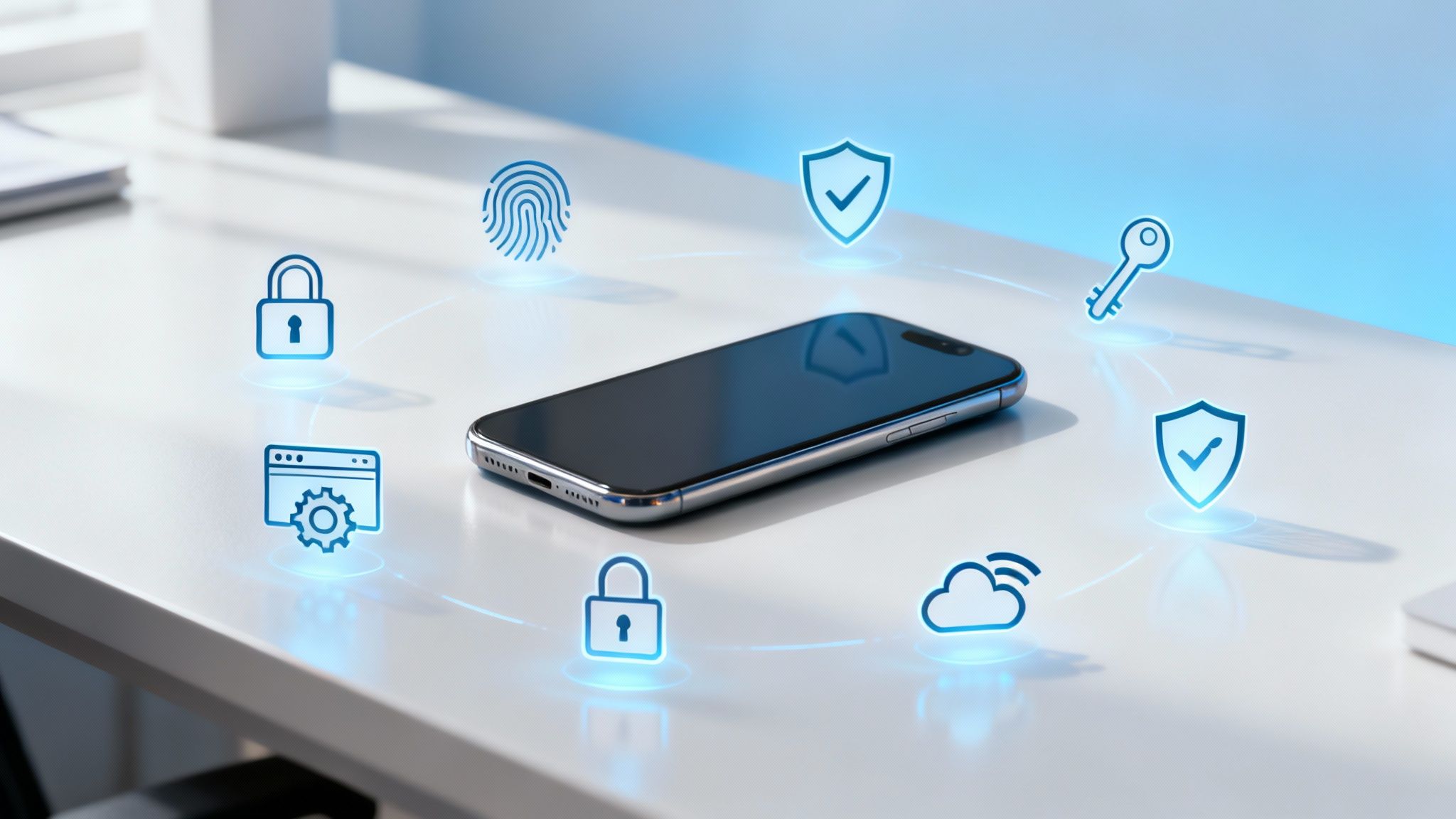
In an age where our lives are deeply intertwined with the digital realm, understanding how to protect personal information is no longer optional, it is essential. The threat landscape constantly evolves, with cybercriminals developing sophisticated methods to access your sensitive data, from financial details to private communications. Protecting yourself requires more than just a passing thought; it demands a proactive and informed approach.
This guide moves beyond generic advice to provide a comprehensive, actionable framework of personal cybersecurity best practices. We will explore eight critical pillars of digital defense, designed to fortify your accounts, secure your devices, and make your online footprint a much harder target for malicious actors. Each section offers practical steps you can implement immediately.
Whether you are a professional managing a digital reputation, a parent safeguarding your family’s online activity, or an individual concerned about identity theft, these strategies are for you. Implementing them will not only secure your data but also empower you to navigate the internet with greater confidence and peace of mind. Let’s begin building your digital fortress, one crucial practice at a time.
1. Use Strong, Unique Passwords with a Password Manager
Your passwords are the front door to your digital life, and using the same key for every door is a significant security risk. A password manager is an essential tool in any personal cybersecurity best practices toolkit, acting as a fortified digital vault for all your credentials. It generates long, random, and unique passwords for every site and service you use, then securely stores and automatically fills them in when you need to log in.
The core benefit is eliminating password reuse, a common habit that cybercriminals exploit. If one service you use suffers a data breach and your password is stolen, hackers will try that same password on your email, banking, and social media accounts in what is known as a “credential stuffing” attack. By using a unique password for each account, you contain the damage of any single breach, protecting your most sensitive information. Leading password managers like 1Password and Bitwarden have built their reputations on preventing these exact scenarios.
How a Password Manager Works
A password manager simplifies security by requiring you to remember only one thing: a single, strong “master password.” This master password is the key that unlocks your encrypted vault, which holds all your other passwords. The best password managers operate on a zero-knowledge architecture, meaning even the company that makes the software cannot access your stored data.
This infographic breaks down the core functions of a modern password manager.

These three functions work together to create a seamless and secure experience, removing the human element of creating and remembering complex credentials.
Getting Started with a Password Manager
Adopting a password manager is a straightforward process. Security expert Troy Hunt, creator of the data breach notification service Have I Been Pwned, strongly advocates for their use as a foundational security measure.
To implement this practice effectively, follow these actionable tips:
- Create a Strong Master Password: Use a long passphrase of at least four random, unconnected words (e.g., “Correct-Horse-Battery-Staple”). This is easy to remember but incredibly difficult for computers to guess.
- Start with Critical Accounts: Begin by changing the passwords for your primary email, financial institutions, and social media accounts. You can migrate less critical accounts over time.
- Use the Built-in Generator: Let the password manager create new, complex passwords for every new account you create. Resist the urge to create your own.
- Enable Emergency Access: Most services offer a feature that allows a trusted contact to access your vault in an emergency. Set this up for peace of mind.
2. Enable Multi-Factor Authentication (MFA) Everywhere
If passwords are the front door to your digital life, Multi-Factor Authentication (MFA) is the high-tech deadbolt. It adds a crucial secondary layer of verification, making it exponentially harder for unauthorized users to access your accounts even if they steal your password. MFA works by requiring two or more independent credentials to prove your identity: something you know (your password), something you have (your phone or a security key), or something you are (your fingerprint or face).
This practice is considered one of the single most effective personal cybersecurity best practices you can adopt. Microsoft’s identity security team, led by Alex Weinert, has reported that enabling MFA blocks 99.9% of automated cyberattacks. The widespread adoption of MFA by institutions like Google, GitHub, and major banks has drastically reduced account takeovers and fraud, proving its real-world effectiveness in protecting sensitive data. Learn more about how to secure your digital footprint on digitalfootprintcheck.com.

How MFA Protects You
MFA operates on the principle of layered security. A stolen password alone becomes useless to a cybercriminal because they cannot provide the second required factor. For example, even with your banking password, they would still need the one-time code generated by your authenticator app or the physical presence of your hardware security key.
This system effectively neutralizes the threat posed by data breaches and phishing attacks where password theft is the primary goal. Organizations like the FIDO Alliance and NIST have established robust standards that guide the implementation of secure authentication, pushing for stronger methods beyond simple passwords.
Getting Started with MFA
Activating MFA across your accounts is a powerful step toward fortifying your online presence. The process is typically found in the “Security” or “Account Settings” section of any major service.
To implement MFA effectively, follow these actionable tips:
- Prioritize Authenticator Apps: Use apps like Google Authenticator, Microsoft Authenticator, or Authy instead of SMS text messages. SMS is vulnerable to “SIM swapping” attacks where criminals transfer your phone number to their own device.
- Invest in a Hardware Key for Critical Accounts: For ultimate security on email or financial accounts, use a physical key like a YubiKey. Google reported zero successful phishing attacks on employees who used security keys.
- Save Your Backup Codes: When you set up MFA, you will be given one-time backup codes. Save these in a secure, offline location separate from your password manager in case you lose your primary device.
- Enable MFA Strategically: Start by securing your primary email account, as it is often the key to resetting all your other passwords. Then move on to financial, social media, and other important accounts.
3. Keep Software and Systems Updated
Your software and operating systems are the foundations of your digital environment, but they are rarely perfect. Developers constantly discover and fix security vulnerabilities, and these fixes are delivered as updates. Keeping your software updated is one of the most critical personal cybersecurity best practices because it closes the security gaps that cybercriminals actively seek to exploit.
The core benefit is eliminating known risks. When a vulnerability is discovered, it’s often documented publicly, providing a roadmap for attackers. The infamous 2017 Equifax breach, which exposed the data of 147 million people, was caused by the company’s failure to apply a known security patch for a vulnerability in its web application software. By consistently updating your systems, you remove these easy-to-exploit entry points, making it significantly harder for attackers to compromise your devices and data.
How Software Updates Enhance Security
Software updates, especially security patches, function like a digital immune system response. They are designed to fix specific weaknesses that could allow malware to infect your device, steal your data, or grant an attacker unauthorized access. The Cybersecurity & Infrastructure Security Agency (CISA) consistently emphasizes that timely patch management is a foundational defense against most cyberattacks.
These updates address several types of vulnerabilities:
- Remote Code Execution: Fixes flaws that could allow an attacker to run malicious code on your device from anywhere in the world.
- Privilege Escalation: Patches bugs that could let malware gain administrator-level control over your system.
- Data Exposure: Closes gaps that might leak sensitive personal information.
By applying these patches, you are effectively reinforcing your digital defenses against the latest known threats.
Getting Started with Regular Updates
Making updates a routine habit is a straightforward yet powerful security measure. Security journalist Brian Krebs has extensively documented how breaches often result from unpatched systems, highlighting the severe consequences of neglecting this simple practice.
To implement this practice effectively, follow these actionable tips:
- Enable Automatic Updates: Configure your operating system (Windows, macOS, iOS, Android) and web browsers to install security updates automatically. This is the single most effective step.
- Check Apps Weekly: Set a recurring reminder to check for updates in your phone’s app store and on your desktop applications. Don’t let update notifications pile up.
- Don’t Forget Firmware: Your home router’s firmware is often neglected. Log into its admin panel quarterly to check for and apply updates, as it is the gateway to your entire network.
- Prioritize Security Patches: If an update is labeled “critical” or “security,” install it immediately. Feature updates can often wait, but security fixes are urgent.
- Retire Unsupported Software: If a device or application no longer receives security updates from its manufacturer, it is a permanent risk. Plan to replace it with a supported alternative.
4. Use a VPN on Public Wi-Fi Networks
Connecting to public Wi-Fi at coffee shops, airports, or hotels is convenient, but it exposes your data to significant risks. A Virtual Private Network (VPN) is an essential personal cybersecurity best practice for protecting yourself on these untrusted networks. It creates a secure, encrypted tunnel between your device and a remote server, making your online activity invisible to anyone trying to eavesdrop on the same network.
This encryption shields you from common public Wi—Fi threats like man-in-the-middle attacks, where an attacker intercepts your traffic to steal login credentials, financial information, or personal messages. By routing your connection through its own server, a VPN also masks your real IP address, adding a crucial layer of privacy. For example, journalists and activists in restrictive regions rely on services like ProtonVPN to communicate securely and bypass surveillance, demonstrating the power of this technology.

How a VPN Secures Your Connection
A VPN works by encrypting all the data leaving your device before it even reaches the public Wi-Fi router. This encrypted data travels to a server operated by the VPN provider, where it is decrypted and sent to its final destination on the internet. Any response is then encrypted again by the VPN server and sent back to your device.
This process effectively hides your browsing activity, downloads, and communications from the local network administrator and any malicious actors. Reputable providers like ExpressVPN and NordVPN operate with strict “no-log” policies, meaning they do not store records of your activity, a commitment that has been tested and verified in real-world scenarios.
Getting Started with a VPN
Implementing a VPN into your daily digital routine is a simple yet powerful step. Edward Snowden’s revelations about widespread government surveillance were a major catalyst for the public adoption of VPNs, highlighting their importance for individual privacy.
To implement this practice effectively, follow these actionable tips:
- Choose a Reputable Provider: Select a VPN service with a independently audited, verified no-log policy and a strong reputation for security.
- Activate Before Connecting: Always enable your VPN before you connect to any public or untrusted Wi-Fi network to ensure immediate protection.
- Enable the “Kill Switch” Feature: This feature automatically blocks all internet traffic if your VPN connection unexpectedly drops, preventing any data from leaking out unencrypted.
- Avoid “Free” VPNs: Many free services monetize their platforms by collecting and selling user data, which defeats the purpose of using a VPN for privacy and security.
5. Regular Data Backups (3-2-1 Rule)
Your most important digital files, from family photos to critical documents, are vulnerable to hardware failure, theft, ransomware, and accidental deletion. A systematic backup strategy is a non-negotiable component of personal cybersecurity best practices, ensuring your data remains recoverable. The 3-2-1 backup rule is a time-tested data protection framework that provides robust defense against data loss.
The core principle is to create redundancy. The strategy dictates that you should have at least three copies of your data, store them on two different types of media, and keep one copy offsite. For example, a photographer whose primary external hard drive fails can restore their entire portfolio from a cloud backup, preventing catastrophic loss. This approach removes the leverage of ransomware attackers, as you can restore your files from a clean, uninfected backup without paying a ransom.
How the 3-2-1 Rule Works
The 3-2-1 rule is a simple yet powerful concept for building a resilient data recovery plan. It addresses multiple potential failure points by diversifying where and how your data is stored. Companies like Backblaze have built their services around making this level of data protection accessible to everyone, not just large enterprises.
This rule breaks down into three core components:
- Three Copies: This includes the original file and at least two backups.
- Two Different Media: Don’t keep all your backups on the same type of storage. You could use your computer’s internal drive plus an external hard drive or a cloud service.
- One Offsite Copy: This protects you from localized disasters like fire, flood, or theft. An offsite copy can be a physical drive stored at another location or, more commonly, a cloud backup service.
These three layers of protection work together to create a system where no single event can wipe out all your data.
Getting Started with a Backup Strategy
Implementing the 3-2-1 rule is more straightforward than it sounds, and automation is key to its success. Peter Krogh, a photographer who formalized the strategy for digital professionals, emphasized its role in protecting irreplaceable creative work. It is an essential practice for anyone with valuable digital assets.
To implement this practice effectively, follow these actionable tips:
- Follow the 3-2-1 Rule: Keep your original data on your computer (Copy 1), back it up to an external hard drive (Copy 2, different media), and use an automated cloud service like Backblaze or Carbonite for your offsite backup (Copy 3, offsite).
- Automate Your Backups: Use software that runs backups automatically in the background. Manual backups are often forgotten, creating gaps in your protection.
- Test Your Restoration Process: Periodically, at least once a quarter, try to restore a few files from your backups. This verifies that the backups are working correctly and that you know how to recover data when you need to.
- Encrypt Sensitive Backups: If your backups contain sensitive financial, personal, or business information, ensure they are encrypted both in transit and at rest.
- Disconnect Offline Backups: For maximum protection against ransomware, disconnect your external backup drive from your computer after the backup is complete. This creates an “air gap” that malware cannot cross.
6. Practice Email and Phishing Awareness
Phishing remains the most common and effective cyberattack vector, using deceptive emails, texts, and messages to trick you into revealing sensitive credentials, downloading malware, or sending money to criminals. Practicing email and phishing awareness is a critical human-focused defense because technology alone cannot catch every sophisticated scam. Since over 90% of data breaches involve a phishing element, your ability to spot a fake is a vital personal cybersecurity best practice.
The core principle is to treat all unsolicited communications with a healthy dose of skepticism. Cybercriminals excel at creating a sense of urgency or fear to make you act without thinking. For example, the 2021 Colonial Pipeline ransomware attack began with a single compromised password, likely obtained through a phishing email. By training yourself to recognize suspicious indicators, verify sender authenticity, and handle links and attachments with caution, you become the strongest link in your own security chain.
How to Recognize Phishing Attempts
Phishing attacks succeed by exploiting human psychology, not just technical vulnerabilities. They often impersonate trusted brands or individuals to lower your guard. The Anti-Phishing Working Group (APWG) and security training platforms like KnowBe4, founded by Stu Sjouwerman, emphasize that user education is paramount in stopping these attacks before they cause damage.
Learning to spot the red flags is the first step. Look for unusual sender addresses, generic greetings like “Dear Customer,” and poor grammar or spelling. The goal of the attacker is to rush you into a bad decision, so any message demanding immediate action should be treated as highly suspicious.
Actionable Tips for Email Security
Integrating email vigilance into your daily routine is a powerful security habit. Former hacker turned security consultant Kevin Mitnick, author of The Art of Deception, built his career on demonstrating how easily people can be manipulated. Protect yourself by making these practices second nature.
To implement this practice effectively, follow these actionable tips:
- Hover Before You Click: Always hover your mouse over links to see the actual destination URL. If the address looks suspicious or doesn’t match the sender’s domain, do not click it.
- Verify the Sender: Carefully examine the sender’s email address for slight misspellings or unusual domains (e.g.,
microsft-support.com). Don’t trust the display name alone. - Question Urgency: Be wary of any message that creates panic, especially those involving financial transactions or credential resets. Scammers use urgency to prevent you from thinking clearly.
- Use a Separate Channel: If you receive a strange request from a known contact, verify it through a different communication method, like a phone call or text message to a known number.
- Navigate Directly: Never enter login credentials on a page you reached via an email link. Instead, type the official website address directly into your browser.
7. Secure Your Devices Physically and Digitally
Your most sophisticated digital defenses can be rendered useless if someone gains physical access to your devices. Securing your devices is a critical personal cybersecurity best practice that involves a two-pronged approach: protecting them from physical theft and unauthorized access while also implementing robust digital safeguards like encryption. A stolen, unencrypted laptop is a direct gateway to your entire digital life.
The core benefit of this dual strategy is creating layered security. Full-disk encryption, such as BitLocker for Windows or FileVault for macOS, ensures that even if a device is stolen, the data remains unreadable without the correct login credentials. This was a key factor in the famous 2016 case where the FBI was unable to access the encrypted iPhone of the San Bernardino shooter, highlighting the power of modern device encryption. Similarly, enabling remote wipe capabilities allows you to erase all data from a lost or stolen device, preventing a physical breach from becoming a catastrophic data leak.
How Device Security Works
Effective device security combines physical awareness with digital locks. It starts with a strong screen lock (a PIN, password, or biometric data) that activates after a short period of inactivity. This is your first line of defense. The second layer is full-disk encryption, which scrambles all data on the storage drive, making it incomprehensible without the decryption key.
Finally, services like Apple’s “Find My” or Google’s “Find My Device” provide a remote safety net. They allow you to locate a misplaced device on a map, make it play a sound, lock it with a message, or, as a last resort, erase it completely. These features work in tandem to protect your data no matter where the device ends up.
Getting Started with Device Security
Implementing strong physical and digital security for your devices is a non-negotiable step. The Electronic Frontier Foundation (EFF) has long advocated for strong encryption as a fundamental right for user privacy and security. Protecting the physical device is just as important as managing your online digital footprint.
To implement this practice effectively, follow these actionable tips:
- Enable Full-Disk Encryption: Turn on BitLocker (Windows), FileVault (macOS), or the default encryption on your iOS or Android device. This should be your first step.
- Set a Strong Screen Lock: Use a 6+ digit PIN or an alphanumeric password on your mobile devices and computers. Set the screen to lock automatically after 5 minutes or less.
- Activate “Find My Device”: Ensure “Find My” is enabled on all your Apple and Google devices before they are lost or stolen. Test it to confirm it works.
- Manage Lock Screen Notifications: Disable notification previews on your lock screen to prevent sensitive information from messages or emails from being exposed to onlookers.
- Handle Old Devices Securely: Before recycling or selling an old device, it’s crucial to learn how to securely wipe your computer before recycling to prevent any personal data from falling into the wrong hands.
- Be Aware in Public: Never leave your devices unattended. Use a privacy screen to prevent “shoulder surfing” when working in public spaces like coffee shops or airports.
8. Practice Social Media Privacy and Information Hygiene
Your social media profiles can be a goldmine for cybercriminals, offering clues to your location, personal relationships, and even answers to security questions. Practicing social media privacy and information hygiene means taking deliberate control over what you share and who sees it. It’s about minimizing your digital attack surface, as attackers often piece together seemingly harmless details to launch sophisticated social engineering or identity theft campaigns.
Oversharing creates vulnerabilities that extend beyond the digital world. For example, criminals have used vacation photos posted in real-time to identify and burglarize empty homes. Similarly, a CEO fraud scam can be orchestrated using a target’s professional history and connections found on LinkedIn. This proactive approach to managing your digital footprint is a cornerstone of modern personal cybersecurity best practices, turning your social profiles from a liability into a well-managed asset.
How Information Hygiene Works
The core principle of information hygiene is to treat your personal data like a valuable resource, sharing it selectively and with purpose. This involves regularly auditing your privacy settings on platforms like Facebook, Instagram, and X to ensure your posts are only visible to a trusted audience. It also means consciously omitting sensitive details like your full birth date, phone number, and home address from public view.
This proactive management prevents malicious actors from building a detailed profile of you. For instance, if a hacker knows your pet’s name, mother’s maiden name, and high school from public posts, they may have enough information to bypass security questions and reset your passwords. To further enhance your information hygiene and protect against digitally manipulated content, learn practical techniques for verifying the authenticity of images by understanding how to check if a photo is real.
Getting Started with Social Media Privacy
Strengthening your social media privacy is an ongoing process, not a one-time fix. The infamous Facebook-Cambridge Analytica scandal, which harvested data from millions of profiles, serves as a powerful reminder of how public information can be misused on a massive scale. Organizations like the Electronic Privacy Information Center (EPIC) continue to advocate for stronger user protections in response to such events.
To implement this practice effectively, follow these actionable tips:
- Conduct Quarterly Privacy Audits: Set a recurring calendar reminder to review the privacy and security settings on all your social media accounts. Platforms frequently update these options.
- Post Vacation Photos After You Return: Avoid broadcasting that your home is unoccupied. Share your travel memories once you are safely back.
- Scrub Sensitive Personal Data: Remove your exact birth date, phone number, and home address from all public-facing profiles.
- Be Skeptical of Friend Requests: Do not accept connection requests from people you don’t know personally. These can be fake accounts designed for data mining.
- Manage Your Digital Footprint: Regularly Google your name to see what information is publicly available and take steps to remove or restrict anything sensitive. For a more comprehensive approach, explore these social media clean up steps to curate a positive online image.
8-Key Personal Cybersecurity Practices Comparison
| Security Practice | Implementation Complexity 🔄 | Resource Requirements ⚡ | Expected Outcomes 📊 | Ideal Use Cases 💡 | Key Advantages ⭐ |
|---|---|---|---|---|---|
| Use Strong, Unique Passwords with a Password Manager | Medium - initial setup and migration needed | Device with compatible OS, internet for sync | Significantly reduced credential stuffing risk | Managing multiple online accounts securely | Eliminates password reuse, strong random passwords |
| Enable Multi-Factor Authentication (MFA) Everywhere | Medium - setup of apps/hardware keys | Authenticator apps, hardware keys, backup codes | Near-elimination of unauthorized account access | Protecting high-value accounts (email, finance) | Strong defense against phishing and theft |
| Keep Software and Systems Updated | Low - mostly automated or scheduled | Bandwidth, storage, occasional downtime | Reduced vulnerability to exploits and malware | All devices and software with security patches | Closes known security holes, improves stability |
| Use a VPN on Public Wi-Fi Networks | Low to medium depending on software | VPN subscription, compatible devices | Secure encrypted internet traffic on untrusted networks | Public Wi-Fi use, remote work, privacy-conscious browsing | Protects data interception, masks IP/location |
| Regular Data Backups (3-2-1 Rule) | Medium - requires setup and ongoing management | Storage devices/cloud services, bandwidth | Data recovery capability, ransomware resilience | Protecting critical data against loss or attack | Ensures business continuity, neutralizes ransomware |
| Practice Email and Phishing Awareness | Low to medium - ongoing training and vigilance | Time investment for user training | Reduced phishing success and credential theft | All email users, especially organizations | No-cost, prevents social engineering attacks |
| Secure Your Devices Physically and Digitally | Medium - multiple hardware/software steps | Devices with encryption support, physical locks | Protection of data on lost/stolen devices | Mobile and portable device users | Prevents data breaches after physical loss |
| Practice Social Media Privacy and Information Hygiene | Medium - regular settings review and behavior | User time and attention | Reduced risk of identity theft and social engineering | Social media users aware of personal data exposure | Limits oversharing, protects reputation |
From Awareness to Action: Securing Your Digital Future
Navigating the complexities of the digital world can feel overwhelming, but securing your online life doesn’t require a degree in computer science. It begins with a fundamental shift in mindset: from passive user to proactive guardian of your personal data. The eight personal cybersecurity best practices we’ve explored are not just isolated tips; they are interconnected layers of a robust defensive strategy. Each one reinforces the others, creating a formidable barrier against cyber threats.
Think of it as building a digital fortress. Your strong, unique passwords, managed by a dedicated password manager, are the high walls. Multi-factor authentication acts as the heavily guarded gate, demanding more than just a single key for entry. Regular software updates are your diligent sentinels, patching weaknesses before they can be exploited. This layered approach is the core of effective digital defense.
Synthesizing Your Security Strategy
The true power of these habits is realized when they become an integrated part of your daily routine. It’s not about executing a single, perfect security overhaul. Instead, it’s about the consistent application of these principles.
- Defense in Depth: Combining a VPN on public Wi-Fi with diligent phishing awareness means you are protected from both network-level snooping and direct social engineering attacks.
- Proactive vs. Reactive: Regularly backing up your data using the 3-2-1 rule transforms a potentially catastrophic ransomware attack into a manageable inconvenience.
- Holistic Protection: Securing your devices physically and digitally while also sanitizing your social media privacy settings ensures your data is safe from both a stolen laptop and a remote data scraper.
Mastering these concepts is more than just protecting your bank account or email inbox. It’s about preserving your privacy, protecting your identity, and securing your peace of mind. In an era where our personal and professional lives are inextricably linked online, these practices are essential for building a resilient and secure digital future.
Your Path Forward: Continuous Vigilance
The cybersecurity landscape is constantly evolving, with new threats emerging just as new technologies do. Therefore, your approach must also be dynamic. Treat personal cybersecurity not as a destination, but as an ongoing journey of learning and adaptation. Stay informed about new scams, review your privacy settings periodically, and never become complacent.
By embracing these personal cybersecurity best practices, you are taking decisive control over your digital footprint. You are transforming from a potential target into a well-defended, informed digital citizen. This commitment is one of the most valuable investments you can make in your own safety and well-being.
Ready to move from defense to offense? While these practices are essential for protecting yourself, understanding what’s already out there is the critical next step. Digital Footprint Check actively scans the web for your exposed personal information, alerts you to data breaches, and provides clear guidance to reclaim your privacy. Take control of your online identity by discovering your digital footprint today at Digital Footprint Check.
